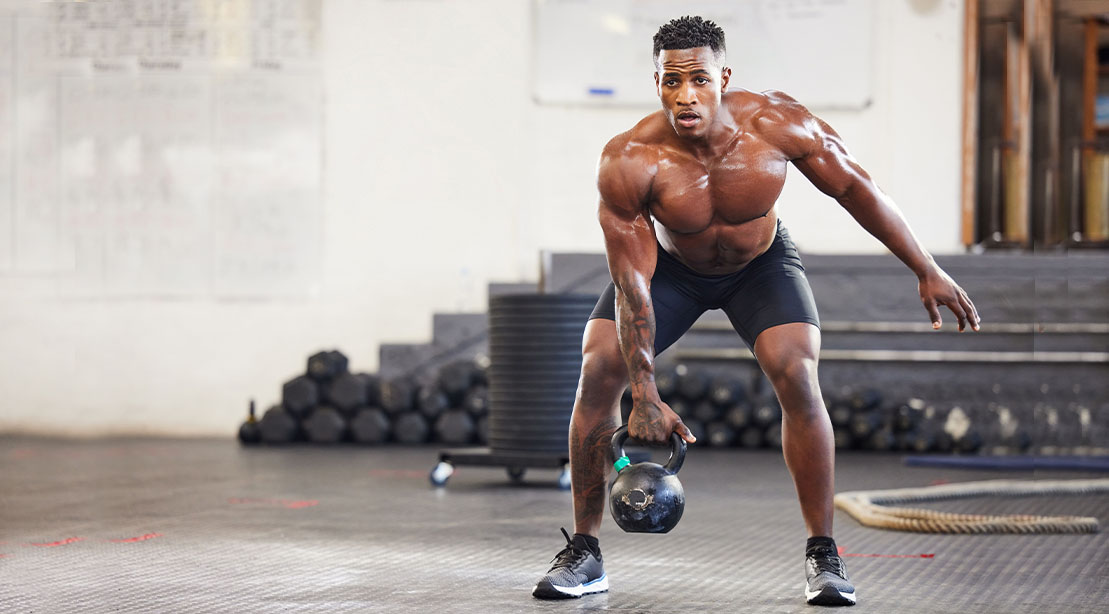Powerful Kettlebell Swing Variations For Strength

Kettlebell Swing Variations for a More Comprehensive Workout
Kettlebell swings are a staple in many training programs, known for their ability to enhance athleticism, develop the posterior chain, and improve endurance and strength. While the traditional Russian kettlebell (KB) swing remains a popular choice, incorporating multiple kettlebell swing variations can provide new stimuli and progressions in your training.
Here are five kettlebell swing variations that you should add to your workout routine.
Deadstop KB Swing
Target Region: Glutes, hamstrings, lower back
Benefits: The Deadstop KB Swing emphasizes explosive power and control, targeting the posterior chain while reducing momentum, which can be beneficial for refining technique and strength.
Setup Tips: Start with the kettlebell slightly in front of you. Hinge at the hips, grip the kettlebell with both hands, and pull it back between your legs like your hiking a football before swinging it forward with a powerful hip thrust. Bring the kettlebell to a complete stop on the ground after each swing to reset your position.
Considerations: Focus on engaging your core and maintaining a neutral spine throughout the movement. The Deadstop KB Swing requires more strength and control than continuous swings, making it an excellent variation for building power and technique.
Sidestep Swing
Target Region: Glutes, hamstrings, lateral hips, adductors, obliques
Benefits: The Sidestep Swing introduces a lateral movement component, which challenges your stability and coordination while engaging the muscles of the lateral hips and obliques.
Setup Tips: Begin with a traditional kettlebell swing stance. As you swing the kettlebell forward, step laterally to the side. Alternate sides with each swing, ensuring that your movements are smooth and controlled.
Considerations: Keep your movements coordinated to avoid losing balance. This variation is great for athletes looking to improve lateral stability and functional strength.
1.5 Stance Single-Arm Swing
Target Region: Glutes, hamstrings, core, shoulder stabilizers
Benefits: The 1.5 Stance Single-Arm Swing challenges your balance and unilateral strength by placing one foot on its toes to simulate a single leg emphasis, which shifts more load onto one side of the body.
Setup Tips: Start by placing one foot on its toes in line with the heel of the working leg. Perform a single-arm swing, maintaining the kickstand stance throughout the set. Switch arms and foot positions for the next set.
Considerations: Focus on maintaining hip alignment and avoiding excessive rotation in the torso. This variation is ideal for those looking to improve unilateral strength and stability.
Dual KB Swing with High Pull
Target Region: Glutes, hamstrings, upper back, shoulders
Benefits: The Dual KB Swing with High Pull not only targets the posterior chain but also engages the upper back and shoulders, making it a more comprehensive full-body exercise.
Setup Tips: Hold a kettlebell in each hand. Perform a standard kettlebell swing, but as you reach the top of the swing, add a high pull by pulling the kettlebells towards your shoulders, leading with your elbows. Control the descent and repeat.
Considerations: Ensure that your back remains straight and that the movement is driven by your hips rather than your arms. This variation is excellent for building upper body strength in addition to the posterior chain.
Lateral Lunge Swing and Clean
Target Region: Glutes, hamstrings, core, quadriceps, adductors
Benefits: The Lateral Lunge Swing and Clean targets the lower body, especially the glutes, hamstrings, and adductors, while also engaging the core for stability. The clean phase enhances upper body strength, particularly in the shoulders and biceps, while the lateral lunge adds a unique challenge to balance and coordination.
Setup Tips: Begin in a standing position with feet shoulder-width apart, holding the kettlebell with both hands. Step out to the side into a lateral lunge while simultaneously swinging the kettlebell between your legs. As you push off the lunging leg to return to the standing position, perform a clean by bringing the kettlebell up to shoulder height. Reset and repeat on the opposite side.
Considerations: Focus on maintaining a strong core and stable posture throughout the movement. Ensure that the knee of the lunging leg tracks over the toes to prevent injury. This variation is excellent for building lateral strength, improving hip mobility, and enhancing overall functional movement.
Programming Tips:
Novice: Start with 2-3 sets of 10-12 reps of each variation, focusing on mastering the form and maintaining control throughout the movements. Rest for 60-90 seconds between sets.
Intermediate: Increase to 3-4 sets of 12-15 reps. Incorporate these kettlebell swing variations into a circuit with minimal rest (30-45 seconds) between exercises to challenge your endurance and conditioning.
Advanced: Perform 4-5 sets of 15-20 reps, integrating the swings into a high-intensity interval training (HIIT) routine. Reduce rest periods to 15-30 seconds or incorporate the swings into a complex or superset with other power or strength movements
Conclusion:
Kettlebell swing variations offer a diverse range of exercises that can be incorporated into your workout routine to improve strength, endurance, and overall athleticism. By incorporating these variations, you can challenge yourself and continue to progress in your training.
FAQs:
Q: What is the primary benefit of kettlebell swings?
A: Kettlebell swings improve strength, endurance, and overall athleticism by targeting the posterior chain and engaging the core.
Q: What is the Deadstop KB Swing, and how does it differ from a traditional kettlebell swing?
A: The Deadstop KB Swing emphasizes explosive power and control, targeting the posterior chain while reducing momentum. It requires more strength and control than continuous swings, making it an excellent variation for building power and technique.
Q: Can kettlebell swings be modified for beginners?
A: Yes, kettlebell swings can be modified for beginners by starting with lighter weights and focusing on proper form and technique. As you progress, you can increase the weight and intensity of the swings.

